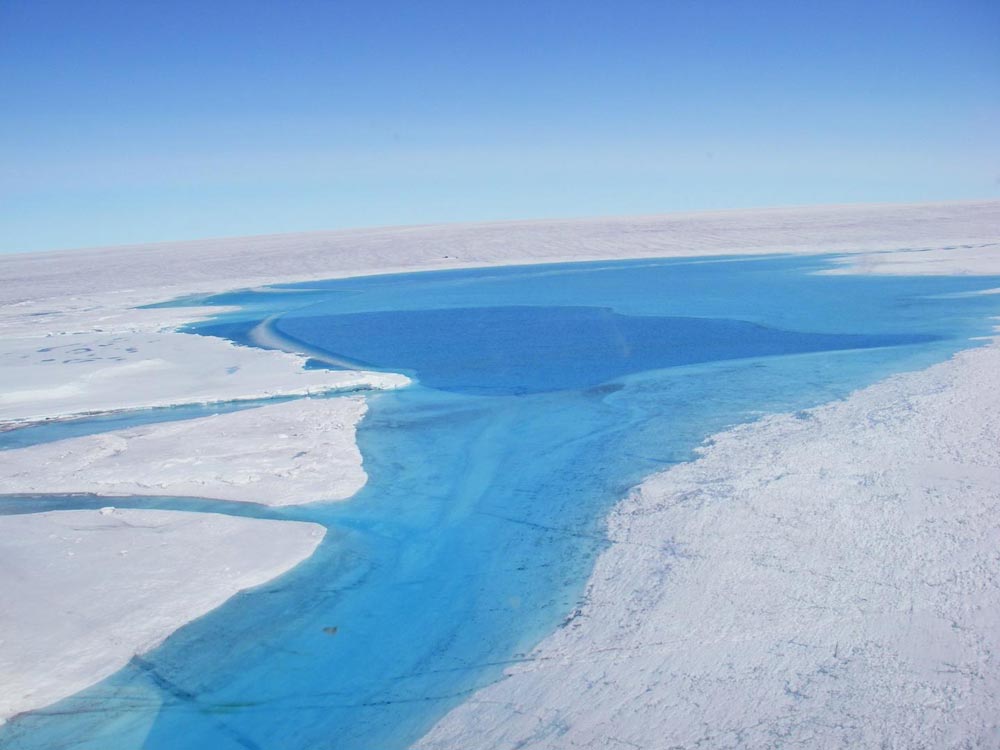

The researchers carried out seismic surveys at a surface lake like this.
Credit: C F Dow
The findings challenge the view that the recent slowdowns in ice flow would continue in the long term.
The research, published in Science Advances, was led by Professor Bernd Kulessa, a glaciologist at Swansea University, and involved experts from the UK, Canada, Sweden and Norway.
Previous research has identified two possible mechanisms for controlling the speed of the ice flow. The first is self-regulation, which proposes that glaciers slow down at the end of the summer because large networks of channels drain water away at the base, increasing frictional resistance to ice flow.
The second is to do with the soft sediments that recent research has shown underlie glaciers; in this model, changing patterns of water flow alternately weaken or strengthen the sediment, making it more or less slippery, and thus enhancing or decreasing the speed of ice flow.
The team's aim was to test the sediment theory for the first time using measurements on the ice sheet.
They carried out seismic surveys at a surface lake on the Greenland Ice Sheet, where the ice is around 1.2 km thick. This involves using a series of controlled explosions to send acoustic waves through the glacier, which then bounce back to a series of geophones -small microphones – set up on the glacier. The data are then analysed to delineate and characterise the physical properties of the sediment underneath the ice.
Their seismic observations confirmed that:
- sediment played the key role in controlling ice sheet flow;
- variability in meltwater supply controls sediment's slipperiness;
- weakening of subglacial sediment leads to accelerated ice flow.
They conclude that:
- The future response of the ice sheet to climate warming will be more complex than a simple case of the flow slowing down due to self-regulation
- Understanding how widespread sediments are and how their properties change with meltwater supply is essential if we are to build up an accurate picture of future patterns of ice flow
Professor Bernd Kulessa of the College of Science at Swansea University, lead researcher on the project, said:
“Greenland's margin has many outlet glaciers that act as fast conveyor belts of ice. Thousands of surface lakes act as taps that deliver meltwater to the ice base, turning it into a slippery bathtub.
Because it is difficult to see beneath them we surmised until recently that the glaciers slip over hard rock, but we realise now that they often slip over sloppy wet sediments instead.
In a warming Arctic climate more ice will melt and make the sediments even sloppier and more slippery, so that fast ice flow can occur long into the future.
This discovery leaves us concerned because we have so far accepted the exact opposite – that Greenland's icy conveyor would slow down.”
###
Notes to editors:
The research paper is called “Seismic evidence for complex sedimentary control of Greenland Ice Sheet flow”. It is published in Science Advances, and is available here after the embargo lifts.
The team included researchers from Swansea, Aberystwyth, Leeds and Cambridge universities in the UK, and from the Arctic University of Norway, the Norwegian Polar Institute, University of Waterloo (Canada) and Uppsala Universitet (Sweden).
Swansea University is a world-class, research-led, dual campus university. The University was established in 1920 and was the first campus university in the UK. It currently offers around 350 undergraduate courses and 350 postgraduate courses to circa 20,000 undergraduate and postgraduate students.
The University's 46-acre Singleton Park Campus is located in beautiful parkland with views across Swansea Bay. The University's 65-acre science and innovation Bay Campus, which opened in September 2015, is located a few miles away on the eastern approach to the city. It has the distinction of having direct access to a beach and its own seafront promenade. Both campuses are close to the Gower Peninsula, the UK's first Area of Outstanding Natural Beauty.
Swansea is ranked the top university in Wales and is currently The Times and The Sunday Times 'Welsh University of the Year'. It is also ranked within the top 350 best universities in the world in the Times Higher Education World University rankings. The results of the Research Excellence Framework (REF) 2014 showed the University has achieved its ambition to be a top 30 research University, soaring up the league table to 26th in the UK, with the 'biggest leap among research-intensive institutions' (Times Higher Education, December 2014) in the UK. The University has ambitious expansion plans as it moves towards its centenary in 2020, as it continues to extend its global reach and realising its domestic and international ambitions. Swansea University is a registered charity. No.1138342. Visit http://www.
Contact details:
Kevin Sullivan, Public Relations Officer, Swansea University press office. k.g.sullivan@swansea.ac.uk Tel 44 (0)1792 513 245; 07768 670 581
Follow us on Twitter: http://www.












